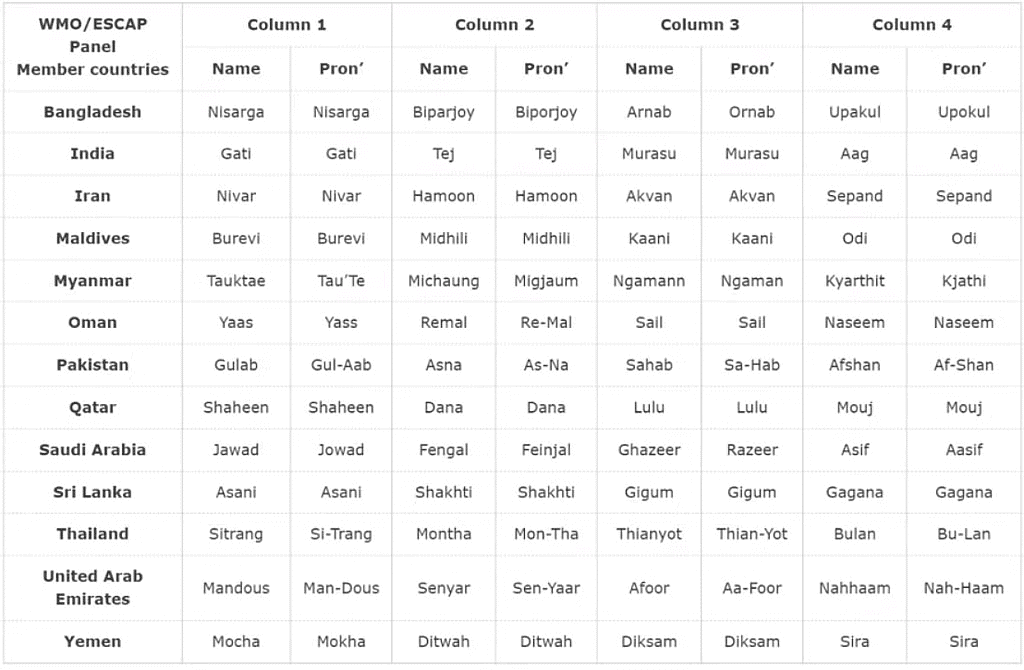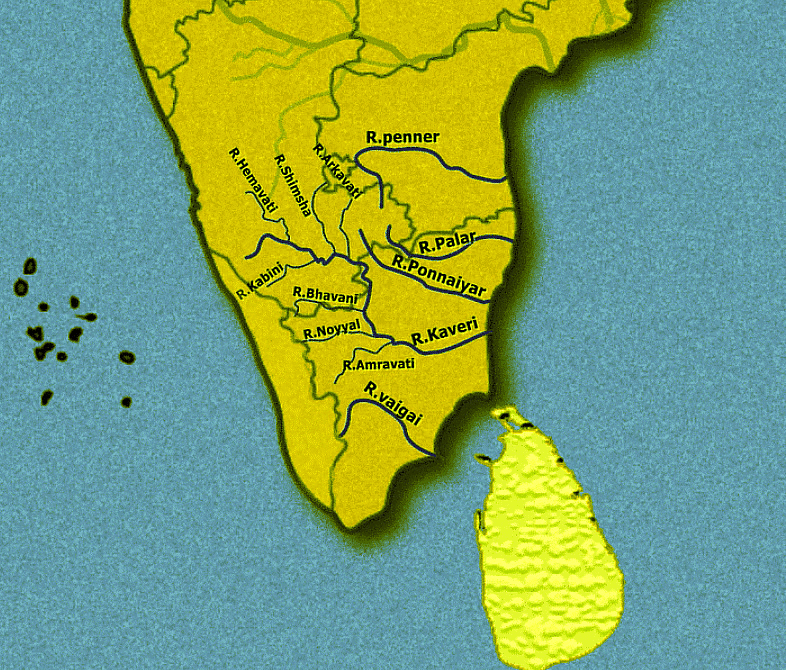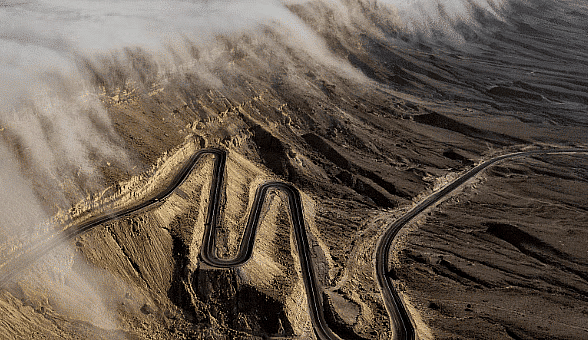Geography: December 2023 Current Affairs | General Test Preparation for CUET UG - CUET Commerce PDF Download
| Table of contents |

|
| Katabatic winds |

|
| India’s Winter Arctic Research |

|
| Cyclone Michaung |

|
| Cauvery basin |

|
Katabatic winds
Context: An intriguing occurrence has been noticed in the Himalayas, where 'katabatic' winds are activated due to elevated temperatures impacting ice masses at high altitudes.
- This results in the movement of cold air toward lower altitudes, potentially mitigating the impacts of the global climate crisis in certain areas.
- The research demonstrates that a difference in temperature between the air above the mountains and the cooler air in direct contact with the ice masses prompts heightened turbulent heat transfer, resulting in a more robust cooling effect on the surface air mass.
Anabatic Winds – These Winds are upslope winds driven by warmer surface temperatures on a mountain slope than the surrounding air column.
Katabatic Winds – Katabatic winds are downslope winds created when the mountain surface is colder than the surrounding air and create a downslope wind.

India’s Winter Arctic Research
Context: The Minister of Earth Sciences inaugurated India’s inaugural winter scientific mission to Himadri, the country's Arctic Research Station located in Ny-Ålesund, situated in the Norwegian archipelago of Svalbard within the Arctic region.
Regarding the Research
- The initial team of the inaugural Arctic winter expedition includes researchers from the hosting National Centre for Polar and Ocean Research (NCPOR), Indian Institute of Technology (IIT) Mandi, Indian Institute of Tropical Meteorology (IITM), and Raman Research Institute.
The Winter Arctic Scientific Expedition
- Venturing into the Arctic during winter enables Indian researchers to conduct distinctive scientific studies amidst polar nights, characterized by nearly 24-hour darkness and sub-zero temperatures. This endeavor broadens India's scientific capacities in the Earth’s polar regions, fostering deeper comprehension of the Arctic's facets, particularly climate change, space weather, sea-ice and ocean circulation dynamics, ecosystem adaptations, and their impacts on tropical weather and climates, including monsoons.
- India has maintained the Arctic research base, Himadri, since 2008, primarily accommodating scientists during the summer months (April to October). Key research focuses encompass atmospheric, biological, marine, and space sciences, environmental chemistry, as well as investigations into the cryosphere, terrestrial ecosystems, and astrophysics.
- By sustaining operations throughout the winter, India joins a select group of nations with Arctic research bases. In recent times, the Arctic region has increasingly captivated scientists engaged in climate change and global warming research.
Note:
- DakshinGangotri was established in Antarctica as early as 1983. Presently, DakshinGangotri lies submerged beneath ice, but India continues to operate two other stations, namely Maitri and Bharti.
- India's scientific missions to both the Arctic and Antarctic regions are supported through the PACER (Polar and Cryosphere) initiative under the Ministry of Earth Sciences (MoES), exclusively managed by the National Centre for Polar and Ocean Research (NCPOR) in Goa, an autonomous institution under the MoES's purview.

Cyclone Michaung
Context: Cyclone Michaung marks the initial cyclonic system to make landfall on the Andhra Pradesh coast following the development of Cyclone Gulab in September 2021.
About Cyclone Michaung
- Cyclone over South-West Bay of Bengal.
- Michaung is named after a suggestion given by Myanmar. It means strength and resilience.
- Upon formation, cyclone Michuang will become the fourth Bay of Bengal cyclonic storm and the sixth cyclone formed in the Indian Ocean in 2023.
Naming of cyclone
- The World Meteorological Organization (WMO) administers the management of unique name lists designed for each tropical cyclone basin. Cyclones originating in various global ocean basins are named by regional specialized meteorological centers (RSMCs) and Tropical Cyclone Warning Centers (TCWCs) situated within those regions. There exist a total of six RSMCs worldwide.
- Member nations associated with the RSMCs propose names for tropical cyclones. For example, the Indian RSMC, representing 13 nations, submits 13 names each for cyclones formed in the region.
- Previously, before the adoption of formal naming protocols, tropical cyclones were named based on geographical locations, objects, or the feast days of saints coinciding with their occurrence. The naming sequence follows a column-wise sequential approach, commencing from the first row in column one and progressing systematically to the last row in column thirteen.
- Names of tropical cyclones in the north Indian Ocean are not reused; once utilized, a name is retired. Additionally, the name of a tropical cyclone originating in the South China Sea that traverses Thailand and enters the Bay of Bengal remains unchanged.
Guidelines to adopt names of cyclones
- The proposed name should be neutral to (a) politics and political figures (b) religious believes, (c) cultures and (d) gender.
- Name should be chosen in such a way that it does not hurt the sentiments of any group of population over the globe
- It should not be very rude and cruel in nature
- It should be short, easy to pronounce and should not be offensive to any member
- The maximum length of the name will be eight letters.
- The proposed name should be provided with its pronunciation and voice over.
- The names of tropical cyclones over the north Indian Ocean will not be repeated. Once used, it will cease to be used again. Thus, the name should be new.

Cauvery basin
Context: A study conducted by scientists at the Indian Institute of Science (IISc), Bengaluru, reveals that the Cauvery basin experienced a depletion of about 12,850 sq. km of natural vegetation from 1965 to 2016, with Karnataka contributing to three-fourths of this decline.
- Karnataka's forest cover constitutes approximately 20% of its total area.
More about the Research:
- The research findings indicate a 46% decline in natural vegetation cover, revealing a reduction of 35% in dense vegetation and 63% in degraded vegetation within the specified period.
- The study highlights concerning alterations in forest cover, notably observed in regions like the Brahmagiri Wildlife Sanctuary, as well as in prominent national parks such as Bandipur and Nagarhole.
- Proposed recommendations include the implementation of integrated catchment management strategies and the adoption of sustainable agricultural practices.
About Cauvery River
- The Cauvery River, also referred to as 'Ponni' in Tamil, stands as the largest river in Tamil Nadu and the third largest in southern India, following the Godavari and Krishna rivers. Its origins lie in Karnataka, specifically Talakaveri situated within the Brahmagiri range in the Kodagu district of the Western Ghats. The river eventually empties into the Bay of Bengal.
- Among its contributing waterways, the left bank tributaries encompass Arkavathi, Hemavathi, Shimsa, and Harangi, while the right bank tributaries include Lakshmantirtha, Suvarnavati, Noyil, Bhavani, Kabini, and Amaravathi.

|
164 videos|800 docs|1160 tests
|
















